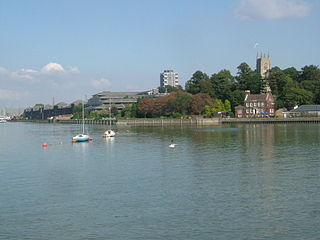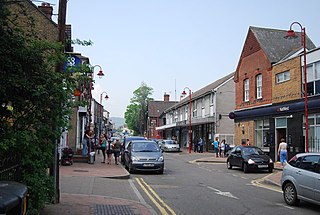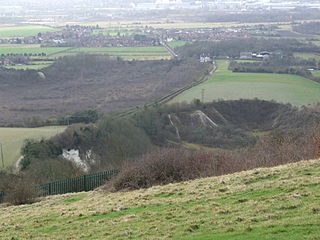
Kent is a county in the South East England region, the closest county to continental Europe. It borders Essex across the entire estuary of the River Thames to the north; the French department of Pas-de-Calais across the Strait of Dover to the south-east; East Sussex to the south-west; Surrey to the west and Greater London to the north-west. The county town is Maidstone.

Aylesford is a village and civil parish on the River Medway in Kent, England, 4 miles (6 km) northwest of Maidstone.

The River Medway is a river in South East England. It rises in the High Weald, West Sussex and flows through Tonbridge, Maidstone and the Medway conurbation in Kent, before emptying into the Thames Estuary near Sheerness, a total distance of 70 miles (113 km). About 13 miles (21 km) of the river lies in East Sussex, with the remainder being in Kent.

Snodland is a town in the borough of Tonbridge and Malling in Kent, England. It lies on the River Medway, between Rochester and Maidstone, and 27 miles (43 km) from central London. At the 2011 Census, it had a population of 10,211.

Tonbridge and Malling is a local government district with borough status in Kent, England. The council is based at Kings Hill. The borough also includes the towns of Tonbridge and Snodland along with numerous villages including Aylesford, West Malling and surrounding rural areas.

The Medway Valley line is the name given to the railway line linking Strood in the Medway Towns via Maidstone West to Tonbridge. High Speed services also link between Maidstone West, Snodland, Strood and London St Pancras International. The section from Maidstone West to Paddock Wood passes through some of Kent's most picturesque countryside along the narrower sections of the River Medway.

Aylesford railway station is on the Medway Valley Line in Kent, England, serving the village of Aylesford. It is 38 miles 74 chains (62.6 km) down the line from London Charing Cross via Strood and is situated between New Hythe and Maidstone Barracks. The station opened on 18 June 1856.

Walderslade is a large suburb in Kent to the south of Chatham split between the unitary authority of Medway and the boroughs of Maidstone and Tonbridge & Malling in South East England. It was, until 1998, fully part of Kent and is still ceremonially associated via the Lieutenancies Act. It encompasses almost all the ME5 postcode district.

Eccles is a village in the English county of Kent, part of the parish of Aylesford and in the valley of the River Medway.
Morton Peto Betts was a leading English sportsman of the late 19th century. He was notable for scoring the first goal in an English FA Cup final.

Ditton is a large village and civil parish in the borough of Tonbridge and Malling in Kent, England. The village is 4.6 miles (7.4 km) west-northwest of Maidstone and 1.8 miles (2.9 km) east of West Malling. The parish, which is long and narrow, straddles the A20, with farmland to the south and industry to the north. It lies in the Medway Valley, on the northern edge of the Kent Weald, and adjoins the ancient parishes of Larkfield, Aylesford and Barming.

Edward Ladd Betts was an English civil engineering contractor who was mainly involved in the building of railways.
Ryarsh is a village and civil parish in the local government district of Tonbridge and Malling in Kent, England. It is home to around 1,000 residents. Ryarsh is west of Maidstone and north of West Malling.
William Willsher was an English cricketer who played a single first-class match for Kent County Cricket Club in 1847.
There have been two baronetcies created in the Baronetage of England for members of the Colepeper family of Kent and Sussex. Both are extinct.
Sir Thomas Culpeper, 3rd Baronet, also known as Colepeper, of Preston Hall, Aylesford, Kent was an English landowner and Whig politician who sat in the English and British House of Commons between 1705 and 1723.

Larkfield is a village in Kent, part of the civil parish of East Malling and Larkfield in the borough of Tonbridge and Malling. Of the two parts of the parish, Larkfield is much more built-up, lying on and north of the main A20 road. The M20 motorway also passes through, with junction 4 residing at the centre of Leybourne on the A228.

Mote Park, also known as The Mote, is a cricket ground in Maidstone in the English county of Kent. It is inside the grounds of the Mote Park and is owned by The Mote Cricket Club. The ground is also used by the Mote Squash Club and Maidstone rugby club. It was used by Kent County Cricket Club as one of their out-grounds for county cricket matches. The club played over 200 first-class cricket matches on the ground between 1859 and 2005.

Gallagher Group Limited started as a civil engineering and groundworks contractor. Then operated civil engineering, property development, 'design and build' contracting and quarrying businesses.

















